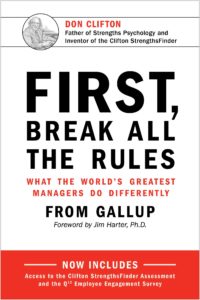By Rose O. Sherman, EdD, RN. NEA-BC, FAAN
 All of us have probably worked for at least one manager who was great. What do these managers do differently and what can we learn from the research about them? In the updated book First Break All the Rules, researchers from the Gallup Corporation answer the question by evaluating 25 years of research with more than 80,000 managers. Gallup is unique because they truly have what has been described as “big data”. They work with thousands of companies globally evaluating employee engagement with the Q12 and have also administered more than 12 million strengths finder assessment.
All of us have probably worked for at least one manager who was great. What do these managers do differently and what can we learn from the research about them? In the updated book First Break All the Rules, researchers from the Gallup Corporation answer the question by evaluating 25 years of research with more than 80,000 managers. Gallup is unique because they truly have what has been described as “big data”. They work with thousands of companies globally evaluating employee engagement with the Q12 and have also administered more than 12 million strengths finder assessment.
This book is worth reading because Gallup has found in their work that “people leave managers, not companies”. It is the front-line manager is the key to attracting and retaining talented employees. This book explains how the best managers select an employee for talent rather than for skills or experience, set expectations, build on each person’s unique strengths rather than trying to fix his or her weaknesses, and get the best performance out of their teams. Some of the recommendations that are made in this book may be counterintuitive to what you have been taught in leadership development programs.
What Great Managers Do Differently
- The best managers select for talent rather than experience. Great managers understand that every role performed with excellence requires talent which is defined as a naturally recurring pattern of thought, feelings and behavior. Experience, intelligence, and determination are also important factors to consider when looking at a job candidate, but the primary focus should be on talent. As an example, the talents of communication and empathy is known to be important in nursing.
- Define outcomes but don’t over-manage how to reach them. To accommodate for different approaches to work, great managers give their employees when they have experience the freedom to find their own paths to agreed-upon results. They need to of course adhere to quality and safety rules and follow organizational policies.
- Great managers build on each staff member’s unique strengths rather than trying to fix the weaknesses. Gallup has found that employees who use their strengths at work are 6X more engaged than other staff. Great managers don’t believe that, with enough training, a person can achieve anything he sets his mind to. They help staff become more of whom they naturally are. Gallup has found that while it is tempting to “fix people”, that rarely works. They teach staff how to manage around their weaknesses with the support of other team members.
- Find the right fit for staff. When developing staff, the manager needs to help their employees to find the right fit for their talents. Sometimes that may not be on your unit. You may hire a nurse who has a talent for developing very close, trusting relationships with patients. Working in an area where the care is episodic may not be the best fit for this nurse but oncology might be.
How Great Managers Give Feedback
- Keep it simple and straightforward – Messages should be tailored to needs of each staff member. Great managers do manage by exception and recognize the need to individualize their management style.
- Do it frequently – many organizations are moving away from the annual evaluation. Part of the rationale is what Gallup has found in their research about how employees (especially Millennials) want to be manage. They want clear, frequent feedback.
- Focus on the future – Great managers understand that staff want to be led by someone that has a genuine interest in their future.
- Require self-tracking – Great managers ask staff to track their own performance, write down their successes, goals and discoveries.
Gallup researchers advise managers that ” people don’t change that much. Instead of trying to put in what God left out, try drawing out what God left in.” This is great advice for all leaders.
Read to Lead
Gallup (2016). First, break all the rules: What the world’s greatest managers do differently. New York: Gallup Press
© emergingrnleader.com 2016


 LinkedIn
LinkedIn Instagram
Instagram